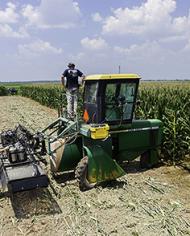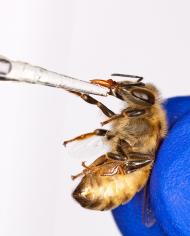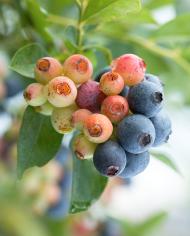ARS has developed a series of four ornamental pepper cultivars named Christmas Lights.
Tellus Articles
A sprayable bioplastic helps deliver beneficial microbes to fight aflatoxins and other pathogens and pests.
ARS scientists are trying to ensure a sustainable future for cranberries.
Learn more about molecular biologist Lisa Ainsworth's work on crop responses to global atmospheric change.
The ARS National Peanut Research Laboratory celebrates 50 years of research on the popular legume.
Cute as Can Bee! Learn more ARS honey bee research.
The Agricultural Research Services strikes gold with a new potato variety.
A mobile system removes phosphorus from manure offering flexibility in using nutrient to fertilize crops.
The ARS Bee Research Lab maintains a Pollinator Garden as an educational tool.
ARS research finds cedarwood oil has potential as a natural pest-control agent and wood treatment.
Hunting for natural enemies of the red imported fire ant is paying off.
A newly developed rotating cross-arm trellis and cane-training system helps blackberry growers.
By tapping into the vibrational signals they use as mating calls.
ARS scientists are on the forefront of research to provide growers and consumers with the very best berries.
ARS scientists play an essential role in bringing products to your grocery store shelves.
Scientists with the USDA are studying ways to keep honeybees stress-free and healthy.
The seeds of a purple-flowered annual known as cuphea could be the source of another insect repellent.
In ARS laboratory studies essential oils in Italian honeysuckle killed 100 percent of mosquito larvae.
An ARS entomologist is focused on finding natural ways to control stink bugs.
The emerald ash borer is destroying ash trees, which are used to make baseball bats.
Growing companion plants with crops creates a “push-pull” effect on pests.
ARS researchers play a role in enhancing the quality of the hops and barley needed to produce beer.
Each year, ARS researchers evaluate about 6,000 samples of malting barley.
ARS scientists are using drones to sample irrigation ponds for E. coli.
There’s surprising news about a pest that’s the main culprit in global honey bee colony losses.
The spotted lanternfly, first sighted in Pennsylvania, is an invasive pest to the United States.
A 1925 film of USDA plant explorers David Fairchild and Palemon Dorsett's collecting trip has been found.
Clip taken from the 1925 silent film “Agricultural Explorations in Ceylon, Sumatra and Java.”
For groundbreaking work on addressing feeding the world in the face of global climate change.































